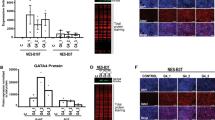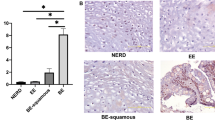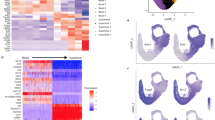Abstract
Zinc deficiency (ZD) in rats increases esophageal cell proliferation and the incidence of N-nitrosomethylbenzylamine-induced esophageal tumors. Conversely, zinc replenishment (ZR) rapidly induces apoptosis in esophageal epithelia and reverses cancer development. We investigated gene expression changes in ZR versus ZD esophageal epithelia to identify differentially expressed genes associated with the antitumor effect of ZR. Weanling rats were fed a ZD diet for 6 weeks to establish esophageal cell proliferation or a zinc-sufficient (ZS) diet. Then, 10 ZD rats were treated with zinc gluconate intragastrically and switched to ZS diet; the remaining 10 ZD and ZS animals were treated with saline. All animals were killed 26–28 h later. Using cDNA microarrays, real-time polymerase chain reaction amplification and RNA hybridization techniques, we identified novel differentially expressed genes, including a RNA-binding protein with two RNA recognition motifs and a zinc knuckle (ZD7), and a DNA/RNA helicase with a DEAD box (ZD10) with two splice variants, ZD10a and ZD10b. In situ hybridization detected increased mRNA expression of ZD7, ZD10a and ZD10b in ZR esophageal epithelia, which displayed markedly increased occurrence of apoptotic cells, relative to ZD epithelia. Overexpression of ZD7 in human esophageal cancer cells resulted in induction of apoptosis and activation of caspase-3 and -7, activities that were inhibited by caspase-specific inhibitors. In addition, ZD7 mRNA levels and zinc-induced apoptosis in rat squamous carcinoma cells were reduced by specific small interfering ribonucleic acids. Thus, ZR rapidly induces ZD7 and ZD10 expression, which in turn stimulates apoptosis. These results provide the beginnings of a molecular pathway for zinc-induced apoptosis under conditions that reverse esophageal tumor initiation.
This is a preview of subscription content, access via your institution
Access options
Subscribe to this journal
Receive 50 print issues and online access
$259.00 per year
only $5.18 per issue
Buy this article
- Purchase on Springer Link
- Instant access to full article PDF
Prices may be subject to local taxes which are calculated during checkout





Similar content being viewed by others
References
Ausubel FM, Brent R, Kingston RE, Moor DD, Seidman JG, Smith JA and Struhl K . (1989). Current Protocols in Molecular Biology. Greene Publishing Associates Wiley-Interscience: New York.
Barch DH, Kuemmerle SC, Hollenberg PF and Iannaccone PM . (1984). Cancer Res., 44, 5629–5633.
Blanchard RK, Moore JB, Green CL and Cousins RJ . (2001). Proc. Natl. Acad. Sci. USA, 98, 13507–13513.
Cintorino M, Tripod SA, Santopietro R, Antonio P, Lutfi A, Chang F, Syrjanen S, Shen Q, Tosi P and Syrjanen K . (2001). Anticancer Res., 21, 4195–4201.
Coia LR and Sauter ER . (1994). Curr. Probl. Cancer, 18, 189–247.
Cousins RJ, Blanchard RK, Moore JB, Cui L, Green CL, Liuzzi JP, Cao J and Bobo JA . (2003a). J. Nutr., 133, 1521S–1526S.
Cousins RJ, Blanchard RK, Popp MP, Liu L, Cao J, Moore JB and Green CL . (2003b). Proc. Natl. Acad. Sci. USA, 100, 6952–6957.
Didenko VV . (2002). Methods Mol. Biol., 203, 143–151.
Didenko VV, Tunstead JR and Hornsby PJ . (1998). Am. J. Pathol., 152, 897–902.
Fong LY, Ishii H, Nguyen VT, Vecchione A, Farber JL, Croce CM and Huebner K . (2003a). Cancer Res., 63, 186–195.
Fong LY, Li JX, Farber JL and Magee PN . (1996). Carcinogenesis, 17, 1841–1848.
Fong LY and Magee PN . (1999). Cancer Lett., 143, 63–69.
Fong LY, Mancini R, Nakagawa H, Rustgi AK and Huebner K . (2003b). Cancer Res., 63, 4244–4252.
Fong LY, Nguyen VT and Farber JL . (2001). J. Natl. Cancer Inst., 93, 1525–1533.
Fong LY, Nguyen VT, Farber JL, Huebner K and Magee PN . (2000). Cancer Res., 60, 4589–4595.
Fong LY, Sivak A and Newberne PM . (1978). J. Natl. Cancer Inst., 61, 145–150.
Fraker PJ and Telford WG . (1997). Proc. Soc. Exp. Biol. Med., 215, 229–236.
Gabrial GN, Schrager TF and Newberne PM . (1982). J. Natl. Cancer Inst., 68, 785–789.
Ho E and Ames BN . (2002). Proc. Natl. Acad. Sci. USA, 99, 16770–16775.
Ishii H, Dumon KR, Vecchione A, Trapasso F, Mimori K, Alder H, Mori M, Sozzi G, Baffa R, Huebner K and Croce CM . (2001). Cancer Res., 61, 1578–1584.
Kadkol S, Juang J and Wu TC . (2003). Methods Mol. Biol., 223, 51–72.
Kindermann B, Doring F, Pfaffl M and Daniel H . (2004). J. Nutr., 134, 57–62.
Lu SH, Chui SX, Yang WX, Hu XN, Guo LP and Li FM . (1991). IARC Sci. Publ., 105, 11–17.
Lu SH, Montesano R, Zhang MS, Feng L, Luo FJ, Chui SX, Umbenhauer D, Saffhill R and Rajewsky MF . (1986). J. Cell Physiol. Suppl., 4, 51–58.
Magee PN . (1989). Cancer Surv., 8, 207–239.
Moore JB, Blanchard RK and Cousins RJ . (2003). Proc. Natl. Acad. Sci. USA, 100, 3883–3888.
Newberne PM, Schrager TF and Broitman S . (1997). Pathobiology, 65, 39–45.
Nodera M, Yanagisawa H and Wada O . (2001). Life Sci., 69, 1639–1649.
Pisani P, Parkin DM, Bray F and Ferlay J . (1999). Int. J. Cancer, 83, 18–29.
Sunderman Jr FW . (1995). Ann. Clin. Lab. Sci., 25, 134–142.
tom Dieck H, Doring F, Roth HP and Daniel H . (2003). J. Nutr., 133, 1004–1010.
Truong-Tran AQ, Ho LH, Chai F and Zalewski PD . (2000). J. Nutr., 130, 1459S–1466S.
van Rensburg SJ . (1981). J. Natl. Cancer Inst., 67, 243–251.
Yang CS . (1980). Cancer Res., 40, 2633–2644.
Acknowledgements
This work was supported by Grants: 02A025-REV from the American Institute for Cancer Research (LYYF), NIH P01 DE12467, CA56036 (CMC), and CA77738 (KH) from the US National Institutes of Health; and funds from the Ministry of Education, Culture, Sports, Science and Technology of Japan, the Kato Memorial Bioscience Foundation, the Chiyoda Health Foundation, and the Suzuken Memorial Foundation, Japan (HI, YF).
Author information
Authors and Affiliations
Corresponding author
Additional information
GenBank Accession number
The accession numbers for the sequences described in this paper are AY303540 and AY303541.
Rights and permissions
About this article
Cite this article
Ishii, H., Vecchione, A., Furukawa, Y. et al. Differentially expressed genes execute zinc-induced apoptosis in precancerous esophageal epithelium of zinc-deficient rats. Oncogene 23, 8040–8048 (2004). https://doi.org/10.1038/sj.onc.1207974
Received:
Revised:
Accepted:
Published:
Issue Date:
DOI: https://doi.org/10.1038/sj.onc.1207974



